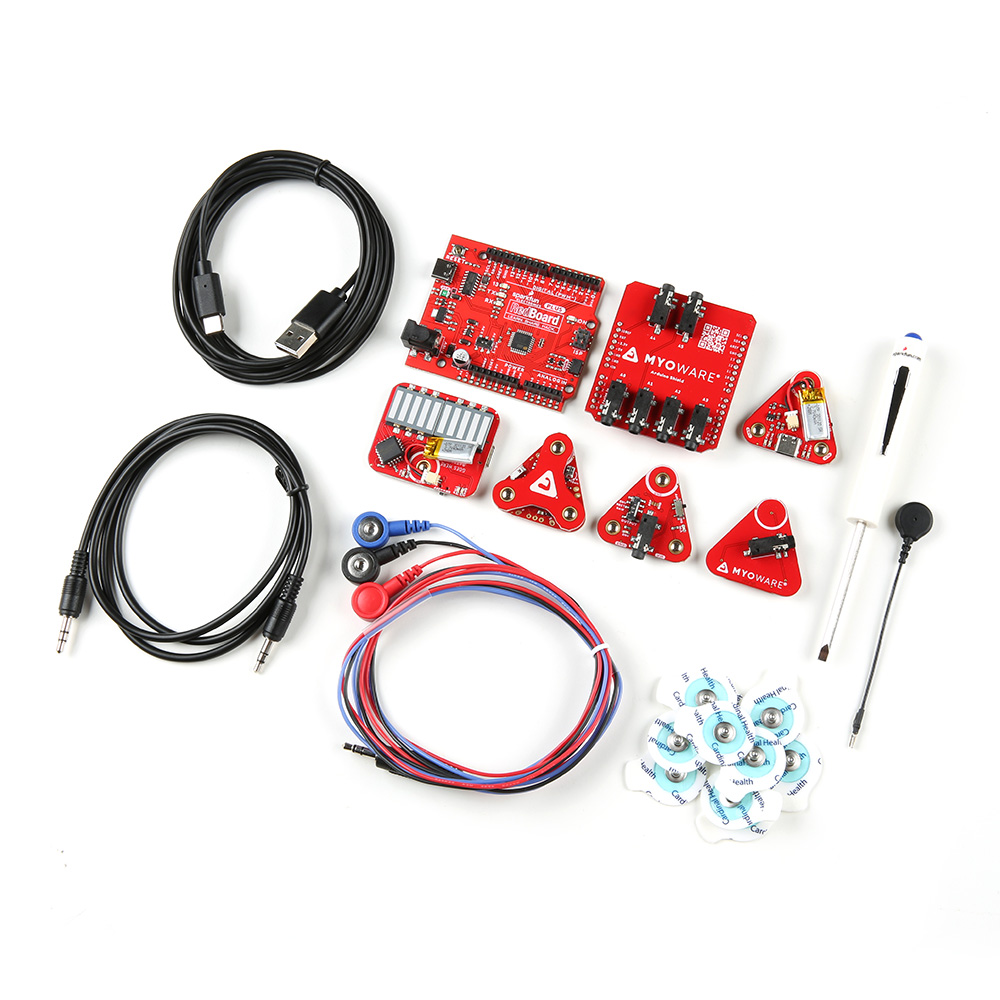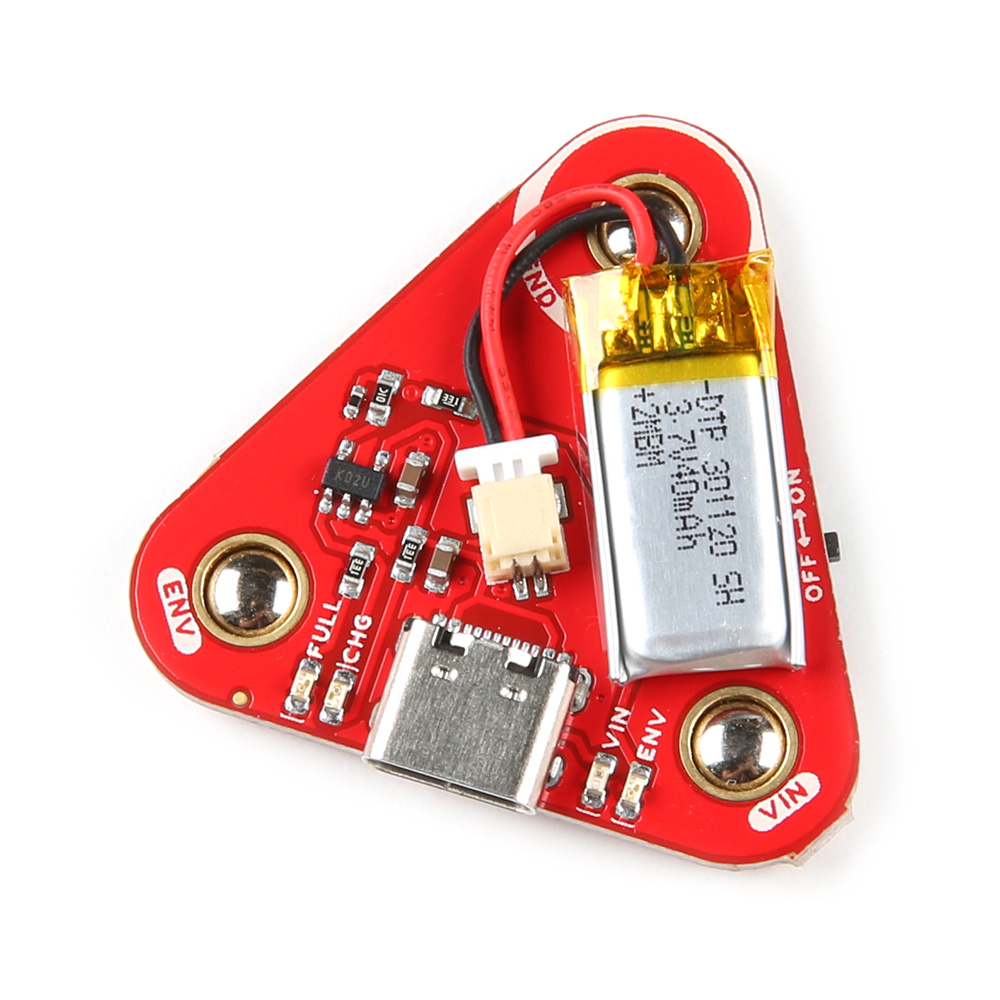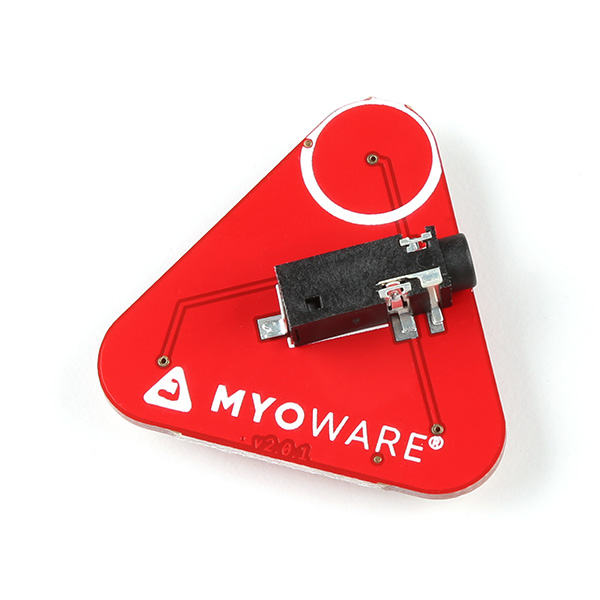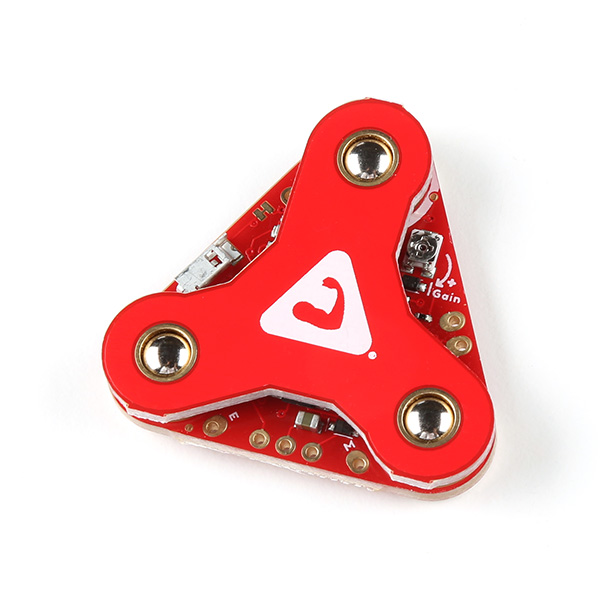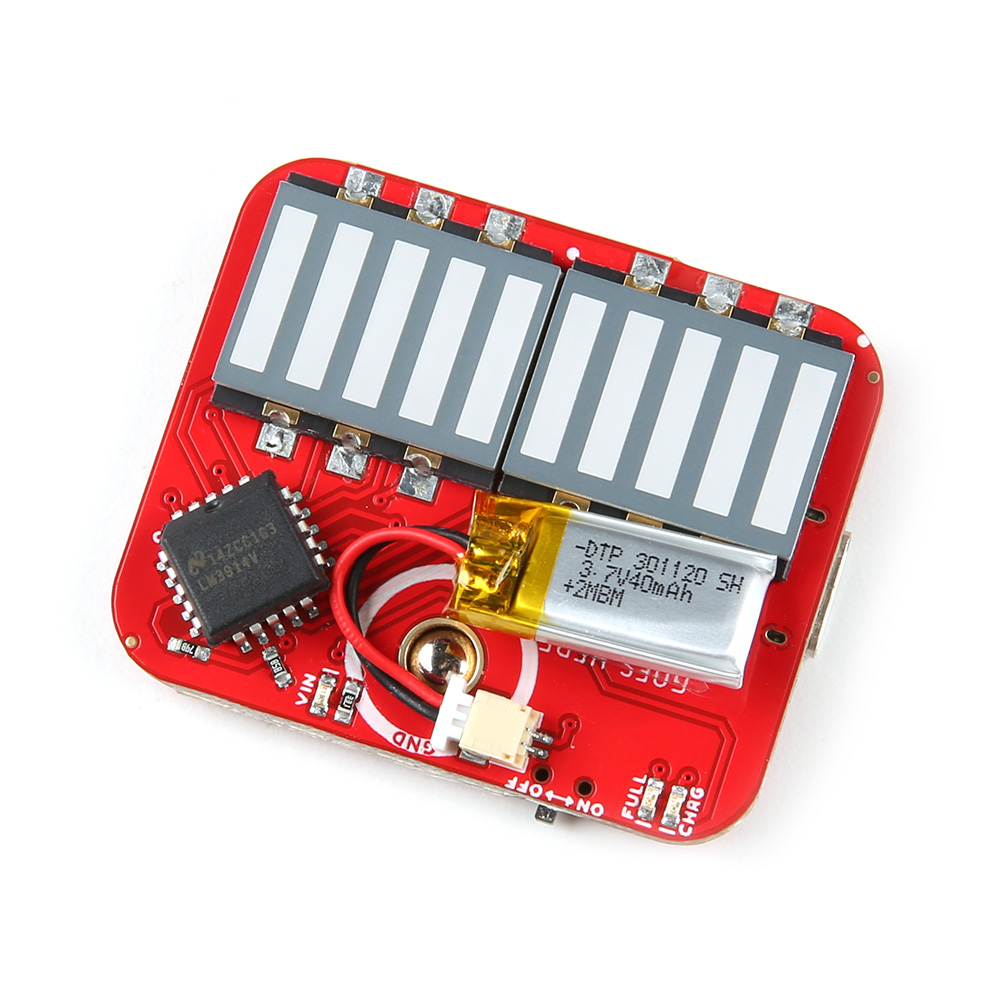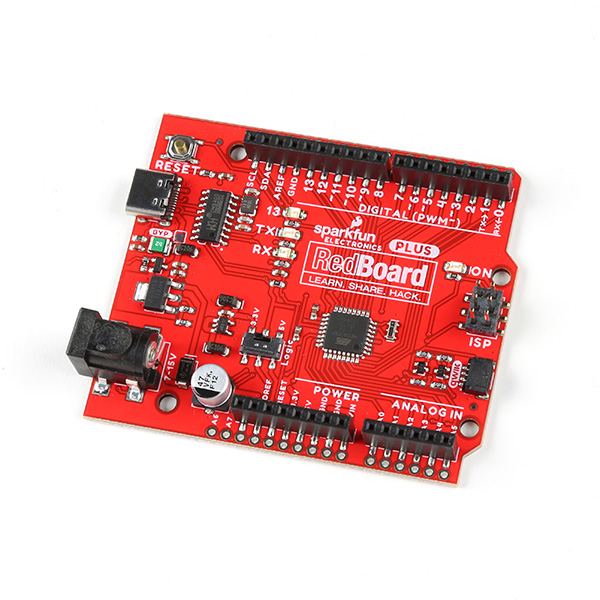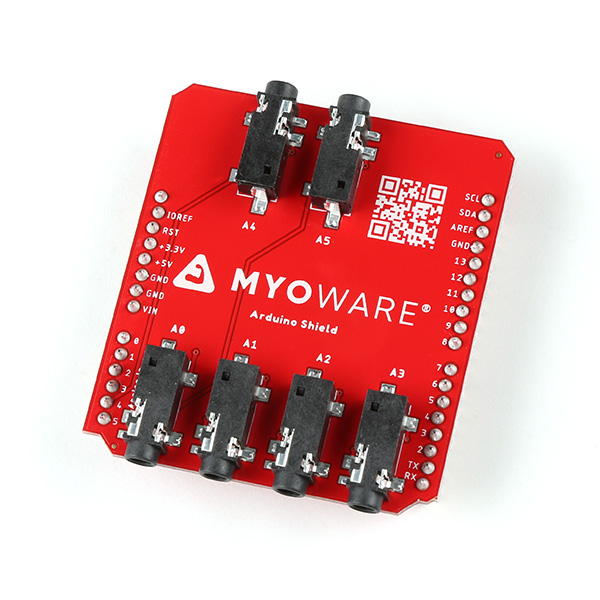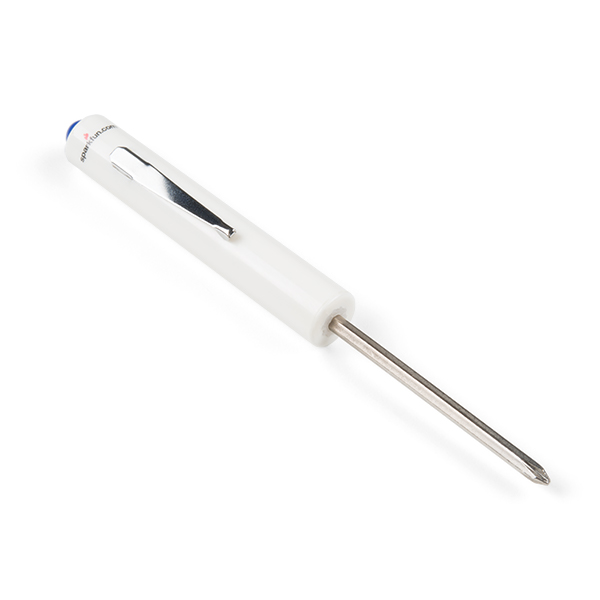MyoWare 2.0 Muscle Sensor Development Kit
The MyoWare® 2.0 Muscle Sensor Development Kit is an Arduino-compatible, all-in-one electromyography (EMG) sensor kit that provides you with all the boards from the MyoWare 2.0 ecosystem to test out different configurations for your application. Depending on your configuration, you can visualize the muscles in action with the MyoWare 2.0 LED Shield or read the analog output using an Arduino-compatible microcontroller! Simply snap on a MyoWare 2.0 Shield, add some EMG sensor pads, attach the sensor to a muscle group, and flex!
The kit also includes a mini screwdriver to easily remove shields, USB A to C cable to recharge the 40mAh LiPo batteries or connecting your microcontroller to a computer, MyoWare 2.0 Reference Cable to connect to large muscle groups, sensor cable to connect to muscle groups away from the sensor, 3.5mm TRS-to-TRS cable to easily connect the MyoWare 2.0 ecosystem to an Arduino-compatible development board using an Uno R3 footprint, and RedBoard Plus.
The MyoWare 2.0 Muscle Sensor included in this kit has been redesigned from the ground up with a new easy-to-use, compact design and upgraded with the latest and greatest chipset improving sensor performance and reliability. The sensor measures muscle activity through the electric potential of the muscle, commonly referred to as surface electromyography (EMG or sEMG for short). When your brain tells your muscle to flex, it sends an electrical signal to your muscle to start recruiting motor units (the bundles of muscle fibers that generate the force behind your muscles).
The harder you flex, the more motor units are recruited to generate greater muscle force. The greater the number of motor units, the more the electrical activity of your muscle increases. MyoWare 2.0 Muscle Sensor will analyze the filtered and rectified electrical activity of a muscle and output a signal (0-VIN volts, where VIN signifies the voltage of the power source) that represents how hard the muscle is being flexed. The innovative connector system eliminates the need to solder connections for the MyoWare 2.0 ecosystem whether you are visualizing the muscles in action with the MyoWare 2.0 LED Shield or reading the analog output with an Arduino-compatible development board.
This kit is constructed to follow the standalone examples using the MyoWare 2.0 Power Shield and LED Shield; and read the output voltage from a single muscle sensor using an Arduino-compatible microcontroller featured in the MyoWare 2.0 Muscle Sensor Guide. For a basic setup without a microcontroller, check out the MyoWare 2.0 Muscle Sensor Basic Kit. The basic kit includes the bare minimum from the MyoWare 2.0 ecosystem to visualize your muscles in action without programming.
Note: This item may take longer to process due to the battery installed in the equipment and therefore does not qualify for same-day shipping policy. Additionally, these batteries can not be shipped via Ground or Economy methods to Alaska or Hawaii. Sorry for any inconvenience this may cause.
Boards in the MyoWare 2.0 ecosystem are not intended for use in the diagnosis of disease or other conditions, or in the cure, mitigation treatment, or prevention of disease, in a man or other animals.
The MyoWare 2.0 ecosystem consists of shields that easily interface with the MyoWare® 2.0 Muscle Sensor, which is a low-cost, Arduino-compatible, all-in-one electromyography (EMG) sensor from Advancer Technologies. The innovative connector system allows users to easily snap shields together with a compact low profile and connect to a microcontroller's analog input to measure raw, filtered, and rectified electrical activity of a target muscle. This eliminates the need to solder connections between boards.
This product is a collaboration with Brian Kaminski from Advancer Technologies. A portion of each sales goes back to them for product support and continued development.
- 1x MyoWare 2.0 Muscle Sensor (Version 2.0.4)
- 1x MyoWare 2.0 Power Shield
- 1x MyoWare 2.0 LED Shield
- 1x MyoWare 2.0 Link Shield
- 1x TRS 3.5mm Cable
- 1x MyoWare 2.0 Arduino Shield
- 1x Reversible USB A to C Cable - 2m
- 1x Disposable Surface EMG/ECG/EKG Electrode - 24mm (10 pack)
- 1x MyoWare 2.0 Cable Shield
- 1x Sensor Cable - Electrode Pads (3 connector)
- 1x MyoWare 2.0 Reference Cable
- 1x SparkFun Mini Screwdriver
- 1x SparkFun RedBoard Plus
Note: This is a more advanced development kit to get started with the muscle sensor and includes the minimum parts to get started using one muscle sensor. Up to five additional muscle sensors can be added to this kit using five corresponding link shields & TRS 3.5mm cables listed above.
MyoWare 2.0 Muscle Sensor Features:
- Wearable Design
- Supply Voltage
- Minimum: +2.27V
- Typically: +3.3V to +5V
- Maximum: +5.47V
- Input Bias Current
- 250pA, max 1nA
- Reverse Polarity Protection
- Three Output Modes
- Raw EMG
- Rectified
- Envelope
- Expandable via Shields
- MyoWare® 2.0 Muscle Sensor Form Factor
- 3x Female Snap Pins (Power and EMG Envelope Output)
- 3x Male Snap Pins (Input Electrodes)
- LED Indicators
- VIN
- ENV
- Reference Electrode Jumper
- Specially Designed For Microcontrollers
- Adjustable Gain
- Board Dimensions
- 37.57mm x 35.90mm (1.48” x 1.41”)
Revision Changes: The following changes for V2.0.4 include:
- PCB board thickness increased.
- NPTH for snap connector buttons.
- Updated footprint for snap connectors buttons with slots for improved cleaning.
- Updated size of reference pin's jumper pad.
- Board Dimensions
- Hookup Guide
- Advancer Technologies: MyoWare® 2.0
- Quickstart Guide (4.37MB)
- Advanced Guide (9.00MB)
- Patents [1]
- MCP73831 Datasheet
- Polymer Lithium Ion Battery (40mAh)
- Arduino Reference Language: ArduinoBLE Library
- GitHub Example Repo
- MyoWare 2.0 Ecosystem Page
[1] Note: This product is patent protected. To prevent counterfeit boards, the Eagle design files and GitHub hardware repository are not shared for boards in the MyoWare 2.0 ecosystem.
MyoWare 2.0 Muscle Sensor Development Kit Product Help and Resources
Getting Started with the MyoWare® 2.0 Muscle Sensor Ecosystem
April 1, 2022
The MyoWare® 2.0 Muscle Sensor, an Arduino-compatible, all-in-one electromyography (EMG) sensor from Advancer Technologies. In this tutorial, we will go over the features and related shields to connect the sensor to a muscle group.
Core Skill: Programming
If a board needs code or communicates somehow, you're going to need to know how to program or interface with it. The programming skill is all about communication and code.
Skill Level: Rookie - You will need a better fundamental understand of what code is, and how it works. You will be using beginner-level software and development tools like Arduino. You will be dealing directly with code, but numerous examples and libraries are available. Sensors or shields will communicate with serial or TTL.
See all skill levels
Core Skill: Electrical Prototyping
If it requires power, you need to know how much, what all the pins do, and how to hook it up. You may need to reference datasheets, schematics, and know the ins and outs of electronics.
Skill Level: Rookie - You may be required to know a bit more about the component, such as orientation, or how to hook it up, in addition to power requirements. You will need to understand polarized components.
See all skill levels
Comments
Looking for answers to technical questions?
We welcome your comments and suggestions below. However, if you are looking for solutions to technical questions please see our Technical Assistance page.
Customer Reviews
3 out of 5
Based on 2 ratings:
myo 2.0
came early!
Not satisfied
Was difficult to find and download the right device interface for the Arduino board red board from sparkfun. Finally got everything setup right but the signal is nonsense and doesn't seem correct according to the documentation and diagrams. Not sure what's wrong.

